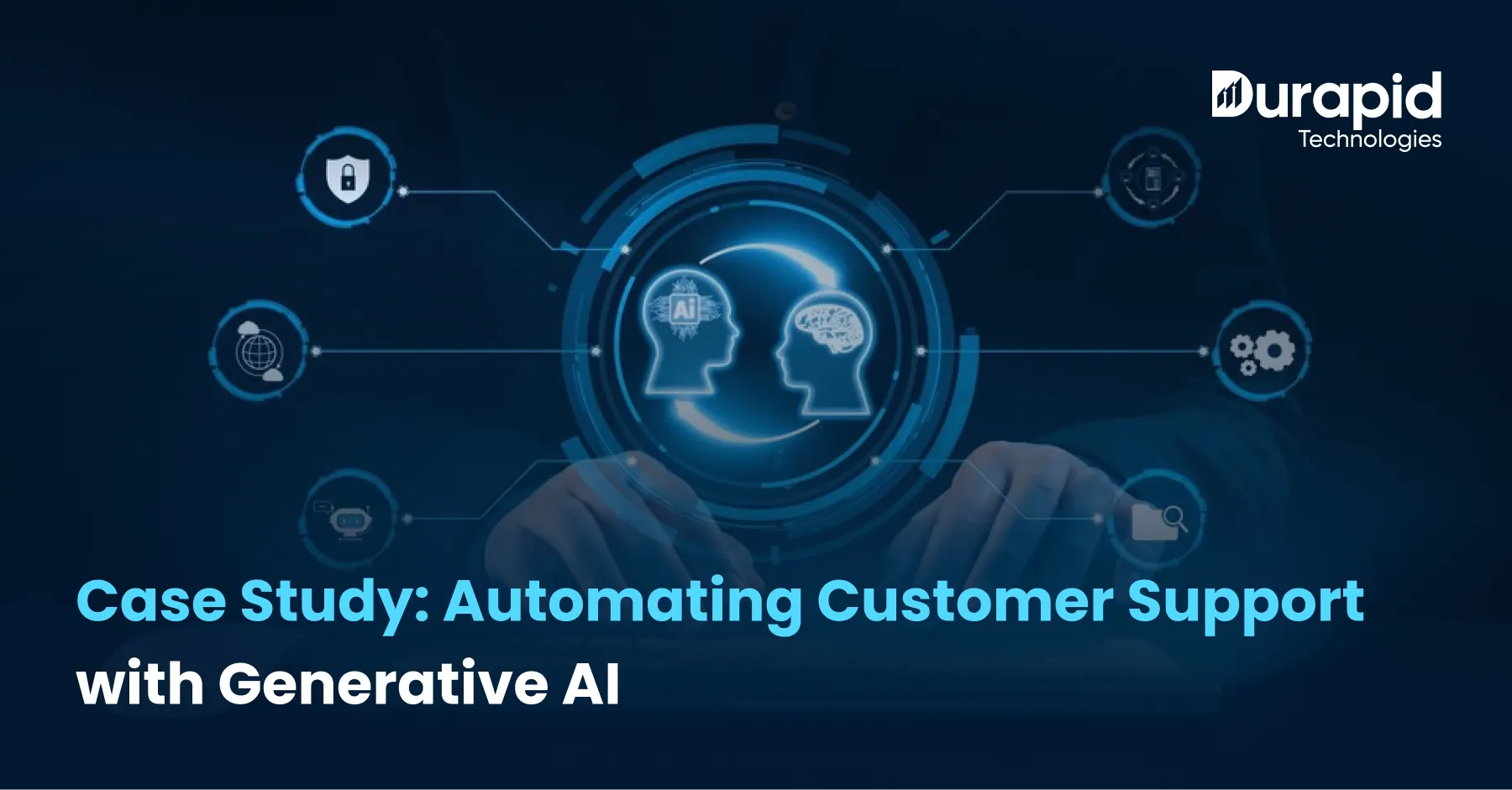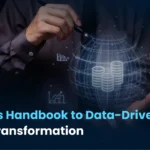Case Study: Automating Customer Support with Generative AI

It’s about time you admitted this:
Customer support is the diet soda of brand experiences.
Bubbly on the outside, zero substance. “Please hold”? No thanks, I’ll switch brands.
But what if you didn’t have to choose between sleeping through music and getting actual help? What if Generative AI in Customer Support made instant, human-level support your minimum, every hour, every channel?
Not in 2030. Not in your dreams. Now.
(Sounds like sci-fi? Stay till the end. And pro tip: Check out what’s possible with Durapid’s AI-powered customer support transformation before another FAQ page eats your soul.)
Why Traditional Customer Support Is Basically… Not Supporting Anyone
Let’s get real: customer service standards? Rock bottom.
- You email, you wait,
- You chat, you wait,
- You call, you wait and get transferred five times.
Meanwhile, survey after survey (and your last five angry chats) scream this truth: People want actual answers, right now, in their language, channel, and mood.
Yet 80% of companies think they’re great at this. Only 8% of their customers agree. PowerPoint decks, meet reality.
The problem:
- Repetitive tickets = burnout.
- Siloed channels = frustration.
- Manual responses = hours lost.
- Scaling up = budget-gone-berserk.
If your “multi-channel” support just means three inboxes blasting out-of-office replies…
It’s time for a gloriously AI-powered pivot.
The AI-Powered Plot Twist: Introducing GenAI to Customer Support
Here’s where the boring chatbots retire and AI-powered customer service gets juicy.
GenAI is what happens when advanced natural language processing techniques meet real-time business logic. Goodbye, “Can I help you with something else?” Hello, deep context, instant recall, and empathy (yes, the feeling kind).
What does this mean?
- The bot knows your customer’s last rage-tweet and their recent order (creepy, but helpful).
- It doesn’t repeat itself. Ever.
- It escalates what matters, handles the rest, and never asks predictable questions like “Did you turn it off and on again?”
And why should you trust this over yesterday’s bots?
Because big brands, including those using Microsoft AI, already are.
Let’s Get Technical: Under The Hood of AI Chatbots for Support
If you think you can just buy a chatbot plugin and nap till next quarter, please… stop here. The rest is for people who care about actual solutions, not demos.
Core Architecture
- NLP Engine:
Think GPT-4, Azure AI, or Google Vertex AI. (And if you love pain, try open source and spend weekends fixing the code.) - Conversational Flow:
Rasa, Dialogflow, or Microsoft Bot Framework. “Fallback” intent FTW. - Machine Learning in Customer Service:
Imagine learning from every “angry Karen” message to evolve. Real-time model retraining, rules for escalation, plus AI that gets (slightly) smarter daily.
Integrations
- CRM Sync:
Salesforce, Dynamics 365, or your tenth spreadsheet. Pulls up customer “what just happened?” in milliseconds. - Self-Service Platform:
Automated ticketing, FAQ, order status, and troubleshooting, all in your customer’s favourite channel. (Here’s a copybook journey you should steal) - Analytics Layer:
How long did that last ticket take? Why did that customer leave the chat furious? Answers, not just dashboards.
Security Because… Data Breaches Suck
- PII masking (yes, must-have)
- GDPR-ready log retention
- Role-based access so no intern leaks your client list
Want an actual deep dive? See Durapid’s real-world data engineering for chatbots.
How To Automate Customer Support with AI: The (Not-So-Boring) Blueprint
Okay, so you’re sold on automation. Or at least curious enough to keep scrolling.
Step 1: Map The Mess
Figure out where you lose customers. Is it in password resets? Payment fails? Shipping drama? Quantify how much time those take, how annoyed people get.
(Tip: It’s way worse than your NPS survey says.)
Step 2: Design The Conversation
Draw the real flows, escalations, apologies, self-serve moments. Get feedback from actual support agents (you know, the underpaid heroes who know what customers want).
Step 3: Integrate Everything
Connect to your CRM, knowledge base, old chat logs (scrubbed clean).
Don’t have that? Time to build. The Microsoft playbook helps.
Step 4: Pilot, Fail, Sprint Again
Soft launch. Monitor where the bot breaks (“hallucinates,” makes up answers, or triggers an emoji riot). Fix. Repeat.
A/B test forever and ever.
Step 5: Scale, Realistically
Add voice, WhatsApp, Instagram DMs. Keep a human handy for edge cases, anger, or “this needs empathy” moments.
For every feature, ask: Will this make customers rage-quit? (If yes, don’t add it.)
For more real talk: Durapid’s implementation journey.
Prove It: The SaaS Case Study You Actually Care About
Confession: We’d love to name-drop a global SaaS client, but NDAs are the bane of cool stories, so here’s a true anonymized version. And no, not a competitor’s glowing review.
Situation:
SaaS unicorn with millions of users, support costs ballooning, NPS tanking. Their support team lived in three time zones (and six Slack channels).
Pain:
- Tickets piling up (passwords, pricing, product complaints)
- Agents drowning
- Customers threatening to churn daily
Solution:
- Implemented a hybrid AI chatbot (Azure OpenAI + Dialogflow, if you’re nosy)
- CRM sync for personalized help
- Escalation to real humans for billing or “I want your manager now” moments
- Language support for global users
Results:
- 70%+ routine tickets gone (bots ate the boring stuff)
- 24/7 instant help, even at 2AM (bots never sleep or call in sick)
- CSAT up 18%, NPS positive for the first time in forever
- Agents now solve fun problems (read: no burnout)
If you need more “wow” factor, check out Durapid’s SaaS transformation playbook.
The Perks: What You Actually Gain (Besides Bragging Rights)
- Blazing fast response (First Reply Time: seconds, not hours)
- Lower support costs (Tier-1 queries = bots, humans for genius-level stuff)
- Consistent on-brand messaging every. single. channel.
- Analytics that don’t suck (Find out why people leave, not just when)
- 24x7x365 support (No holidays for bots, sorry humans)
- Customer happiness you can graph (Everyone loves a positive CSAT trend)
Want stats? Sprinklr has some wild numbers on GenAI chatbots and Gartner predicts chatbot adoption will double this year.
Under The Hood: How Natural Language Processing Techniques Power Support
“AI” isn’t just slapping a chatbot on your website, pouring coffee, and posting on LinkedIn that you’re “innovating.”
The real deal:

- Intent Recognition: “Cancel my order” is not the same as “Where is my order?” Machines need to know this.
- Entity Extraction: Pulling “Order #54321” and “angry” out of your customer’s angry rant, automagically.
- Memory Management: Bots remember the last convo, never ask twice.
- Sentiment Analysis: “Just checking” vs “I’d like a refund, now.” Bots need to FEEL the difference.
- Generative Response: Not just canned replies, actual, personalized, context-rich answers.
Common AI Trapdoors (aka, How to Not Screw This Up)

- LLM Hallucination: Sometimes, your bot just… makes stuff up. Keep a human in the loop for high stakes or billing.
- Garbage Data = Garbage AI: Good data, regular training, and constant tuning or you’re doomed.
- Forgetting Escalation: Not every problem is a “bot problem.” Humans are essential for edge cases.
- Security Gaps: Data privacy isn’t optional, especially with AI customer support tools.
Recommended: Deep-dive into Deloitte’s GenAI pitfalls playbook and Voicespin’s compliance guide.
The Tech Behind Automating Customer Support with Generative AI: Durapid’s No-BS Breakdown.
Picking the Right AI Brain
We don’t just slap any bot on your website and call it a day. Nope. Durapid hand-picks Large Language Models (LLMs) that can actually understand what people are saying, like the real deal GPT-4 powering Microsoft Azure AI or Google Vertex AI. These aren’t dumb rule-based bots; they get context, humour, frustration, even the “please hurry up, I’m late” vibe.

We’re talking:
- Intent classification: Knowing what the heck your customer really wants (not just random keywords).
- Entity extraction: Like finding the order number buried in a lengthy rant.
- Contextual memory: Remembering conversations even if the customer jumps from web chat to email or phone.
- Sentiment analysis: Detecting when you’re annoyed or happy so the bot can react accordingly.
- Generative answers: Crafting replies on the fly, not just copy-pasting FAQs.
And Durapid engineers wrap all this in microservices, meaning we can fix, update, or scale individual parts, like a tech Lego set.
Making It Feel Personal with Data Integration
Here’s where it gets juicy: AI alone is just words on screen. Durapid connects it with your actual enterprise systems, your CRM (think Microsoft Dynamics 365, Salesforce), ticketing tools like Zendesk or ServiceNow, and knowledge bases.
That means the bot:
- Knows who you are, your past tickets, your preferences, no “Sorry, can you repeat that?” nonsense.
- Can open or update a ticket instantly if the query needs more human magic.
- Pulls from live, updated information, no stale “last updated 2018” manuals here.
Don’t worry, all these connections talk to each other through secure APIs that don’t leak your secrets.
Deployment: Cloud, On-Prem, or Both – Whatever Fits You
Durapid gets that not everyone’s IT playground is the same. Some love the elastic cloud for 24/7 uptime and easy updates (Azure Kubernetes Service, anyone?). Some operate in regulated zones that demand on-prem or hybrid models, keeping sensitive info locked tight, HIPAA, GDPR, SOC2 compliance all checked.
We build flexible architectures that scale like a boss when traffic surges, because support requests don’t keep business hours, and neither should your bots.
Keeping It Smarter Every Day
AI isn’t set-and-forget. It’s like your pet dog, needs training and love.
Durapid sets up ongoing feedback loops:
- Chat logs get anonymized and fed back to train the model on real-world phrases.
- Live agents spot where bots stink and step in to fix or flag bad answers (human-in-the-loop).
- Metrics like tickets resolved in the first go, customer satisfaction scores, escalation rates, all monitored to tweak and tune performance.
- We run A/B tests to see which script version actually stops people from smashing their keyboards in frustration.
FAQs You’ll Actually Want to Read
Q: How to automate customer support with AI, really?
- Map all repetitive questions (hint: That’s 70% of your tickets)
- Pick an LLM/NLP engine you trust
- Plug in your knowledge base and CRM
- Test with real customer messages (not just demo data!)
- Analyze, tweak, retrain forever
Q: What are the tangible benefits of generative AI in customer service?
- Resolution times plummet, agents smile more, customers spend more, and your boss finally praises your ops team.
- For numbers: CX Today’s big list of use cases.
Q: Are AI chatbots for support really plug-and-play?
- Nope. You need a great model, perfect data, smooth integrations, and an obsession with user experience.
- But the results are worth the hustle.
Real Talk Conclusion: Generative AI in Customer Support Isn’t Coming.
It’s Here. What’s Your Move?
If you’ve read till here (bonus points!) you now know:
- Generative AI in customer support isn’t just automation, it’s the future of loyalty, retention, and (finally) customer delight.
- Heroes will blend human empathy with machine speed. The laggards will offer, well, just “please hold.”
Be the brand that never asks your customers to wait.
Book a free consultation with Durapid today. Find out how to make your support tick, scale, and, dare I say, delight people, one AI-powered reply at a time. (Yes, it’s free. No, we won’t spam you with a newsletter unless you ask.)
Contact Our Real Experts
Wanna see the tech before it’s buzzworthy?
Ping the Durapid team here, promise, actual humans + bots both reply faster than your current support ticket turnarounds.
You made it to the end. Now go automate something already. The future (and your competition) won’t wait.





